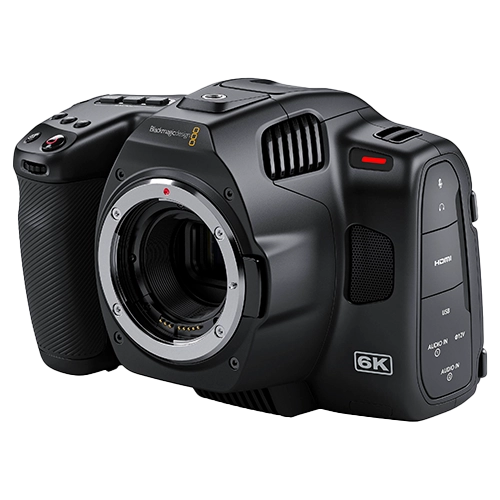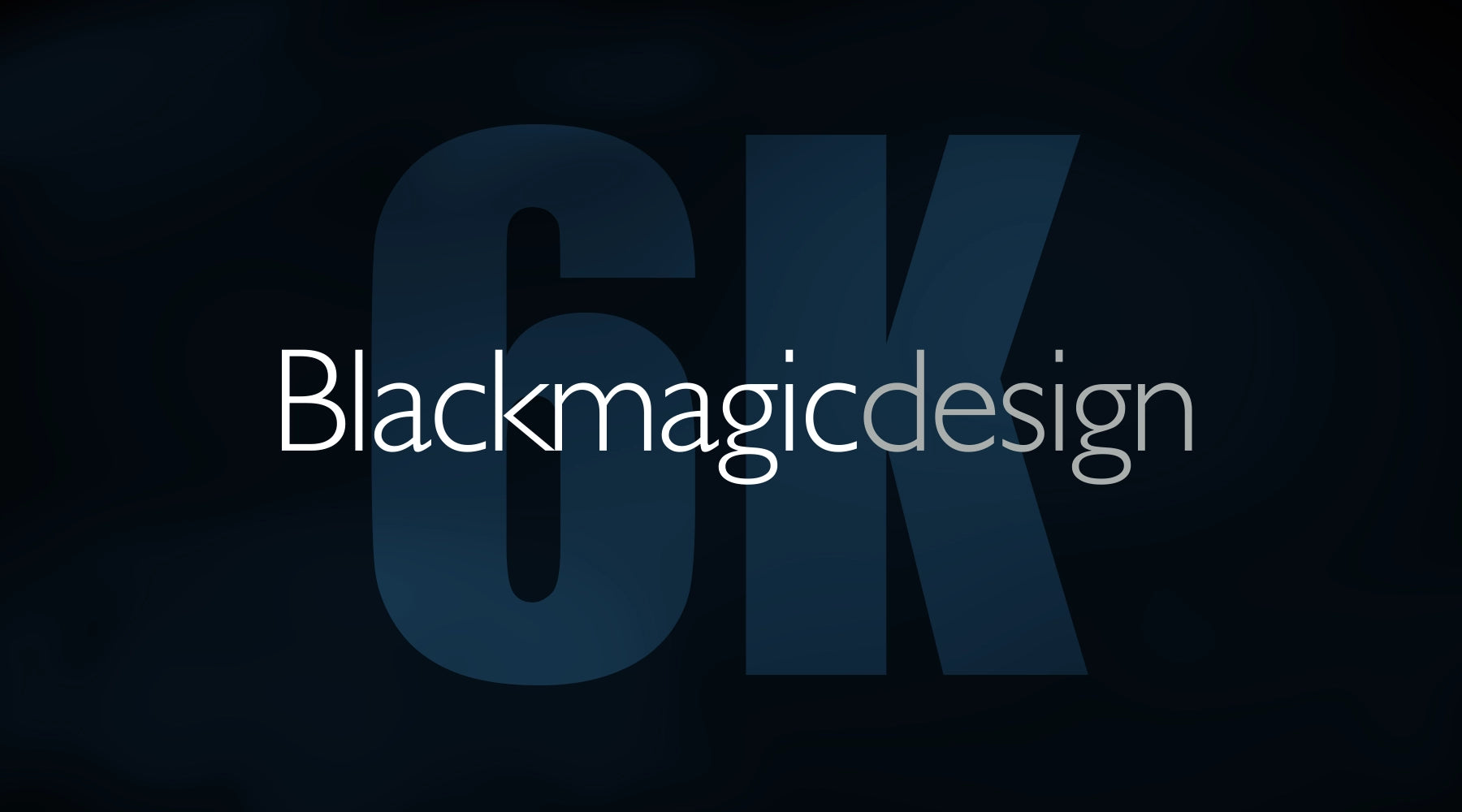

Setting up, recording, and working with 4K/6K footage with a Blackmagic camera
4K/6K video recording has become the new standard for modern filmmaking, and Blackmagic Design is one of the leading companies in the industry, offering high-quality cameras capable of recording footage at these resolutions. In this guide, we'll take a look at how to set up, record, and work with 4K/6K footage using a Blackmagic camera.
Setting Up The Camera:
Before you start recording, you need to make sure your Blackmagic camera is set up properly.
Select a codec:
There are two main codecs used in Black Magic cameras for you to choose from, Blackmagic RAW and ProRes.
Blackmagic RAW Codecs
Raw refers to unprocessed, uncompressed, and sensor-level data captured by the camera. It provides the highest level of image quality and flexibility in post-production. Blackmagic cameras typically use their proprietary raw format called Blackmagic RAW (BRAW). BRAW offers several advantages:
- High-Quality Image: Raw captures data directly from the camera's sensor, preserving the maximum dynamic range and colour information, allowing for greater control over the final image.
- Flexibility: Raw files provide extensive latitude for adjusting exposure, white balance, colour grading, and other parameters during post-production without sacrificing image quality.
- Compression Options: BRAW supports various compression options, such as constant bitrate (3:1, 5:1, 8:1, 12:1), constant quality, or even uncompressed. This allows users to balance file size and image quality according to their needs.
- Metadata: BRAW files also store metadata like lens information, ISO, exposure settings, and more, which can be useful during the editing process.
Blackmagic cameras, depending on the model, may support different variations of BRAW, such as BRAW 3:1, BRAW 5:1, or BRAW Q0/Q5. Each variation offers a different balance between compression and image quality.
ProRes Codecs
ProRes is a family of high-quality video codecs developed by Apple. It is widely used in the professional filmmaking industry due to its excellent image quality and efficient compression. Blackmagic cameras offer ProRes recording as an alternative to raw, providing users with more options based on their work flow and storage capabilities.- ProRes 422: This is the standard ProRes format, which offers a balance between file size and image quality. It provides excellent colour reproduction and is suitable for a wide range of projects.
- ProRes 422 HQ: This version provides a higher data rate and preserves more image information, resulting in better quality files. It is ideal for projects that require extensive post-production, visual effects, or colour grading.
- ProRes 422 LT: This variant offers a slightly lower data rate compared to ProRes 422, making it useful for projects that require smaller file sizes while maintaining good quality.
- ProRes 422 Proxy: This version is highly compressed, resulting in significantly smaller file sizes. It is mainly used for offline editing or situations where low-resolution proxies are sufficient, with the intention of relinking to higher-quality files later.
- ProRes 4444: This codec supports full-colour resolution with an alpha channel, allowing for high-quality compositing and preserving transparency information.
Blackmagic cameras may support different ProRes flavours, but the specific options vary depending on the camera model and firmware version.
Both raw and ProRes codecs have their advantages and are widely used in professional filmmaking and video production. The choice between them depends on factors like post-production requirements, desired image quality, available storage capacity, and the intended work flow.
Select a Resolution:
Full-Frame or Sensor Resolution:
Blackmagic cameras typically have a native sensor resolution, which is the maximum resolution at which the camera can capture the entire sensor's area. This resolution option provides the highest level of detail and image quality. It is suitable for projects where maximum image fidelity is desired, such as feature films, high-end commercials, or any production that demands uncompromising visual quality.
UHD (Ultra High Definition) or 4K:
UHD or 4K resolution is commonly used in professional video production and broadcast. It offers a resolution of 3840 x 2160 pixels, which is four times the resolution of Full HD (1920 x 1080). UHD is suitable for a wide range of projects, including documentaries, corporate videos, web content, and television broadcasts. It provides excellent detail while remaining compatible with most modern displays and delivery platforms.
DCI 4K (Digital Cinema Initiative):
DCI 4K has a resolution of 4096 x 2160 pixels and is the standard resolution used in digital cinema projection. It is slightly wider than UHD and is specifically suited for cinematic applications. DCI 4K is commonly used for theatrical releases, film festivals, and high-end cinematic projects where the content is intended for large cinema screens.
4K 2.4:1:
This resolution option has a wider aspect ratio of 2.4:1, which is commonly used for a cinematic wide-screen look. It provides a resolution of 4096 x 1716 pixels. The 2.4:1 aspect ratio is often preferred for capturing a more immersed cinematic experience, emphasizing wide vistas or creating a distinct visual aesthetic. It is suitable for narrative films, music videos, and other projects where a wider cinematic look is desired.
2.8K Anamorphic:
Anamorphic lenses capture a wide-screen image that is horizontally compressed and must be desqueezed during post-production to achieve the correct aspect ratio. The 2.8K anamorphic resolution provides a resolution of 2868 x 1512 pixels, which is specifically tailored for anamorphic lenses. Anamorphic shooting is popular for achieving a distinct, cinematic look with characteristic lens flares and a unique bokeh. It is often used in feature films, commercials, and music videos that aim to capture a vintage or stylized aesthetic.
2.6K 16:9:
This resolution option offers a standard 16:9 aspect ratio and a resolution of 2560 x 1440 pixels. It provides a slightly higher resolution than Full HD (1920 x 1080) and is suitable for projects that require a higher level of detail and image quality while remaining within the 16:9 standard. It is commonly used for broadcast television, documentaries, corporate videos, and online content where a higher resolution is desired without the need for larger file sizes associated with higher resolutions.
Custom Resolutions:
Some Blackmagic cameras may offer the flexibility to shoot at custom resolutions. This feature allows you to tailor the resolution to your specific project requirements, such as matching the output resolution of a particular display or integrating with existing footage shot at a non-standard resolution.
It's important to note that specific resolution options may vary depending on the model and firmware version of the Blackmagic camera. When choosing a resolution, consider the desired aspect ratio, intended visual aesthetic, post-production capabilities, and delivery requirements for your project.
Setting Up Dynamic Range
Dynamic range refers to the camera's ability to capture a wide range of tones, from the darkest shadows to the brightest highlights. Blackmagic cameras provide different dynamic range options to accommodate different lighting conditions and creative preferences:
Film Dynamic Range:
This setting is designed to emulate the dynamic range of traditional film stocks. It provides a pleasing roll-off in the highlights and shadows, mimicking the characteristic look and tonality of film. It is often preferred for projects that aim for a more cinematic aesthetic.
Video Dynamic Range:
This setting maximizes the camera's dynamic range, aiming to capture the widest range of details in both shadows and highlights. It offers a more natural and balanced look with extended latitude for colour grading and post-production adjustments. This setting is commonly used for broadcast, documentaries, and projects that prioritize capturing the most information possible.
Extended Video Dynamic Range:
Some Blackmagic cameras may offer an extended video dynamic range option. This setting further extends the dynamic range capture, providing additional detail in both highlights and shadows. It can be beneficial in challenging lighting conditions or situations where preserving as much information as possible is critical.
The choice of dynamic range setting depends on your desired look, the lighting conditions you're working with, and the amount of control you want in post-production.
Setting up the sensor area
Blackmagic cameras provide sensor area settings that allow you to choose how the camera utilizes the sensor area during recording. These settings affect the field of view, crop factor, and potential image scaling:
Full Sensor:
This setting uses the entire sensor area to capture the image. It provides the widest field of view and utilizes the full resolution and sensor characteristics. It is the default setting and is suitable for most applications.
Windowed Sensor:
This setting applies a crop to the sensor area, effectively reducing the field of view and increasing the effective focal length of lenses. It can be useful when using lenses designed for smaller sensors or when a tighter shot or a specific focal length is desired.
Sensor area settings are particularly relevant when using lenses that are designed for different sensor sizes, as they can help maintain the desired framing or match the characteristics of specific lenses.
Frame Rate
Frame rate refers to the number of individual frames captured per second (fps). Blackmagic cameras offer various frame rate options, allowing users to choose the desired temporal resolution and capture motion in different ways. Common frame rate options include:
- 24 fps: This is the traditional frame rate used in cinema and is known for providing a cinematic look. It is commonly used for narrative films, documentaries, and other cinematic projects.
- 25 fps: This frame rate is commonly used in countries with PAL video systems. It provides a smooth and natural look and is suitable for television broadcasts and certain regions' standards.
- 30 fps: This frame rate is commonly used in countries with NTSC video systems. It offers a smooth and fluid motion and is commonly used for television broadcasts, live events, and sports coverage.
- Higher Frame Rates: Blackmagic cameras often support higher frame rates such as 60 fps, 120 fps, or even higher. Higher frame rates are commonly used for slow-motion effects, capturing fast-paced action, or achieving a smooth and detailed slow-motion look in post-production.
The choice of frame rate depends on the intended look, the project's requirements, and the playback medium.
Off-Speed Recording
Off-speed recording refers to capturing footage at a frame rate different from the project's intended playback frame rate. This technique allows for creating slow-motion or fast-motion effects during post-production. Blackmagic cameras often provide the flexibility to shoot at higher frame rates and later conform the footage to the desired playback speed.
For example, if you shoot at 120 fps and your project's intended frame rate is 24 fps, you can slow down the footage in post-production by playing it back at 24 fps. This results in a smooth and detailed slow-motion effect.
Similarly, if you shoot at a higher frame rate than the intended playback frame rate, playing it back at the standard frame rate will result in fast-motion or time-lapse effects.
Off-speed recording allows for creative manipulation of time and can add a dynamic and visually striking element to your projects.
Recording 4k Footage
Once your camera is set up, it's time to start recording. To do this, simply press the record button on your Blackmagic camera. You can also use an external recorder, such as a Ninja V, to record footage from the camera.
When recording, it's important to monitor your audio levels to ensure they're not too low or too high. Use headphones to monitor your audio levels and adjust them as needed. For more information on recording audio, check out this guide we put together for just that.
Storage requirements for 4k footage
Data Rates:
4K and 6K video capture requires a significant amount of storage due to the high data rates involved. The specific data rates vary depending on the camera model, chosen codec, and frame rate. For example, shooting in Blackmagic RAW (BRAW) at higher compression ratios can result in lower data rates compared to shooting in uncompressed or high-quality ProRes formats.
It's essential to consult the camera's specifications or user manual to determine the specific data rates for your camera model and chosen recording settings. This information will help you estimate the amount of storage required for a given shooting scenario.
Storage Media Options:
Blackmagic cameras typically offer different storage media options for recording footage. Common options include:
- SSDs (Solid-State Drives): Blackmagic cameras often support recording to high-speed external SSDs. SSDs provide fast data transfer rates and are well-suited for capturing high-resolution footage. They are available in various capacities, such as 500GB, 1TB, 2TB, and beyond. SSDs are reusable and offer flexibility in transferring and offloading footage to post-production systems.
- CFast or CFexpress Cards: Some Blackmagic cameras use CFast or CFexpress cards as recording media. These cards provide fast data transfer rates and are available in different capacities. However, it's important to ensure the camera model is compatible with the specific type of card being used.
- SD or UHS-II Cards: Certain Blackmagic camera models may offer SD or UHS-II card slots for recording. These cards are widely available, but their data transfer rates may be more limited compared to SSDs or specialized memory cards. They are generally suitable for lower data rate recording formats or situations where a lower capacity is sufficient.
FORMAT, FORMAT, FORMAT!
Before you go ahead and start recording, remember to format your storage when connected to the camera. This ensures the full storage capacity is available and that the drive is compatible with the camera.
It's crucial to use storage media that meets the camera's recommended specifications for reliable and uninterrupted recording.
Storage Capacity Planning:
When planning storage for 4K/6K filming, consider the following factors:
Shooting Duration:
Estimate the expected shooting duration and the amount of footage you plan to capture per day. Multiply the average data rate per second by the expected shooting time to calculate the approximate storage capacity required for a shoot.
Backup and Redundancy:
It's advisable to have backup storage options to ensure data safety. This may include duplicate SSDs or additional storage media to back up footage during shoots.
Post-Production Workflow:
Consider the post-production workflow and storage requirements for editing, colour grading, and archiving. Allocate sufficient storage space for storing and working with the captured footage during the editing and post-production stages.
It's recommended to have ample storage capacity available to avoid running out of space during a shoot and to ensure smooth and uninterrupted recording.
Working with 4K Footage
After you've recorded your footage, it's time to start working with it. One of the benefits of shooting in 4K/6K is that you have more flexibility in post-production. You can crop and reframe your footage, as well as adjust colours and exposure.
To edit your footage, you'll need a video editing software. Blackmagic offers their own editing software called DaVinci Resolve into the software and start editing.
When exporting your footage, choose the appropriate resolution and compression settings for your project's needs.
Summary:
Setting up, recording, and working with 4K/6K footage with a Blackmagic camera may seem intimidating at first, but with the right knowledge and tools, it's a rewarding experience. Remember to choose the appropriate resolution and frame rate, monitor your audio levels while recording, and use a video editing software to edit your footage. With these tips, you can produce high-quality footage that meets your project's needs.

